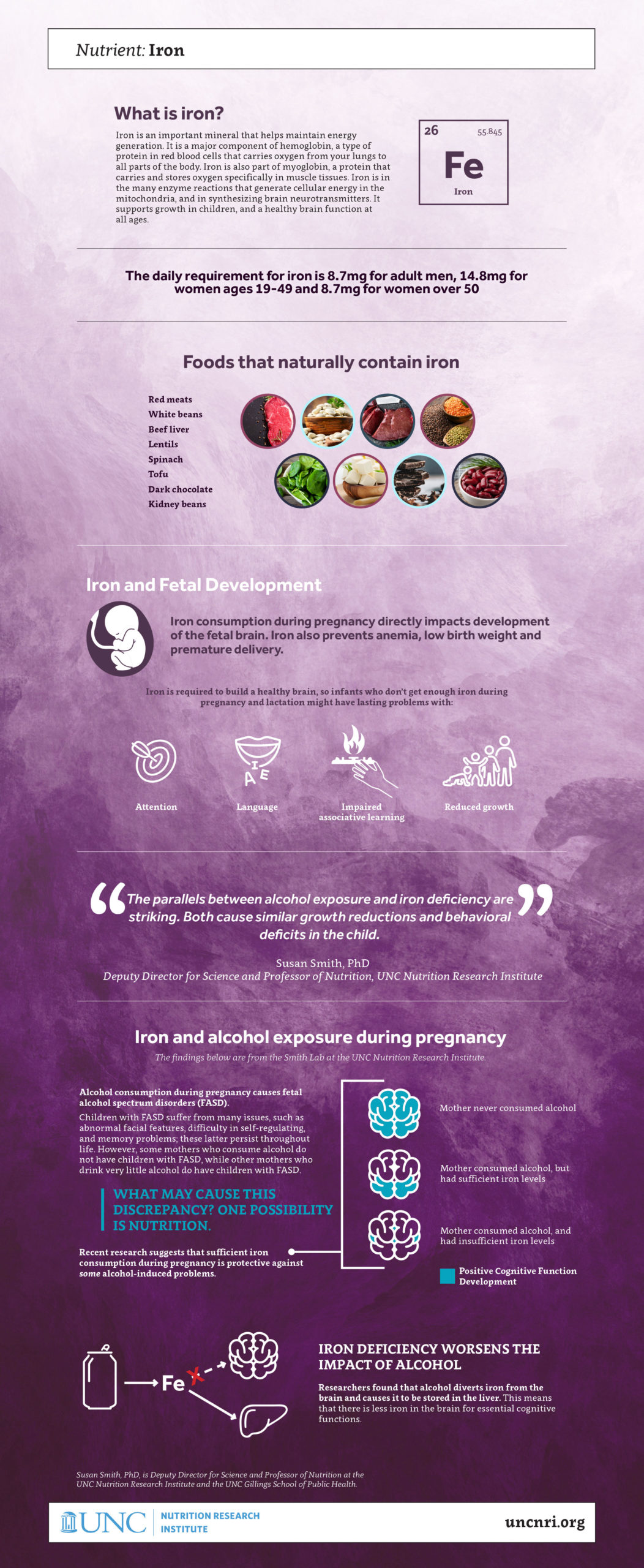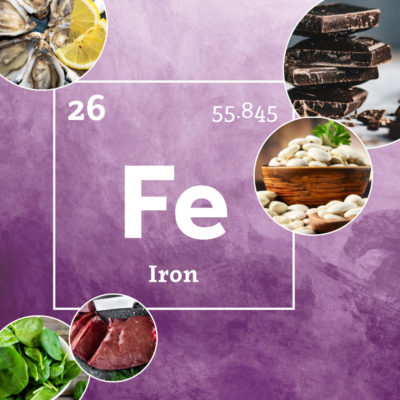Iron is an important mineral that helps maintain energy generation. It is a major component of hemoglobin, a type of protein in red blood cells that carries oxygen from our lungs to all parts of the body. Iron is also part of myoglobin, a protein that carries and stores oxygen specifically in muscle tissues. Iron is in the many enzyme reactions that generate cellular energy in the mitochondria, and in synthesizing brain neurotransmitters. It supports growth in children, and healthy brain function at all ages.
The daily requirement for iron is 8.7mg for adult men, 14.8mg for women ages 19-49 and 8.7mg for women over 50. The higher amounts in women of child-bearing age are due to blood loss through menstruation and because of the rapid growth of the fetus requiring extra blood circulation during pregnancy.
Dietary iron has two main forms: heme and nonheme. Plants and iron-fortified foods contain nonheme iron only, whereas meat, seafood, and poultry contain both heme and nonheme iron. Non-heme iron is not well-absorbed by the body; thus, vegetarians must eat higher amounts of iron-containing foods. Foods naturally high in iron are red meats, white beans, beef liver, lentils, spinach, tofu, dark chocolate, and kidney beans.
Iron consumption during pregnancy directly impacts development of the fetal brain and prevents anemia, low birth weight, and premature delivery. Because iron is required for building a healthy brain, infants who don’t get enough iron during gestation and lactation might have lasting problems with attention, language development, associative learning, and physical growth.
“The parallels between alcohol exposure and iron deficiency are striking. Both cause similar growth reductions and behavioral deficits in the child,” explains Susan Smith, PhD, deputy director for science and professor of Nutrition at the UNC Nutrition Research Institute.
Alcohol consumption during pregnancy causes fetal alcohol spectrum disorders (FASD). Children with FASD suffer from many issues, including reduced growth, difficulty self-regulating, and memory problems; these latter persist throughout life. However, some mothers who consume alcohol do not have children with FASD, while other mothers who drink very little alcohol do have children with FASD.
The Smith Lab at the UNC Nutrition Research Institute is studying what may cause this discrepancy and believes the answer lies in nutrition. Recent research suggests that sufficient iron consumption during pregnancy is protective against some alcohol-induced problems. And iron deficiency worsens the impact of alcohol.
Researchers found that a mother’s alcohol consumption diverts iron from the fetus’s brain and causes it to be stored in the liver. This means that there is less iron in the brain for essential cognitive functions. Exposure to the mother’s alcohol causes inflammation that puts the fetus’ cells into alert status, which results in iron being stowed away in the liver.
“One of the body’s defenses against infection is to put iron into storage,” Smith explains. “In this case though, the mother doesn’t have an infection. She’s drinking alcohol. But the body doesn’t know the difference.”
Smith emphasizes that when iron is stockpiled in the liver it is virtually useless because alcohol prevents other organs from using it. Meanwhile, the fetal brain is stunted by the lack of iron, which can result in changes in behavior and cognitive function that can have negative consequences throughout a person’s life.
When it comes to alcohol, iron, and pregnancy, it is most important for women to know that when they are pregnant, they should increase their iron intake and think twice about drinking alcohol.
“Alcohol prevents a baby’s healthy development. It may also prevent the baby from using nutrients efficiently,” Smith says. “Our work strives to understand and address that problem. This way, we can give women the best scientific advice to help them make the best decisions for their health and for their family’s health.”
More articles on Iron Research at the NRI:

